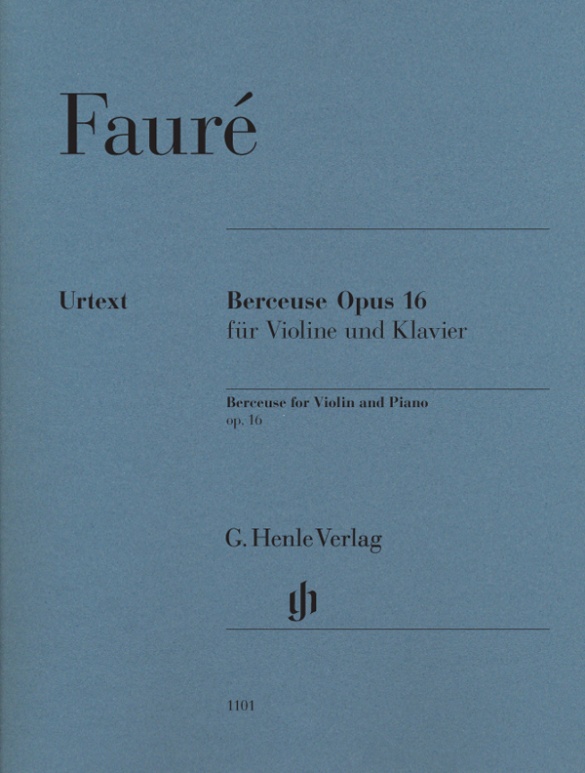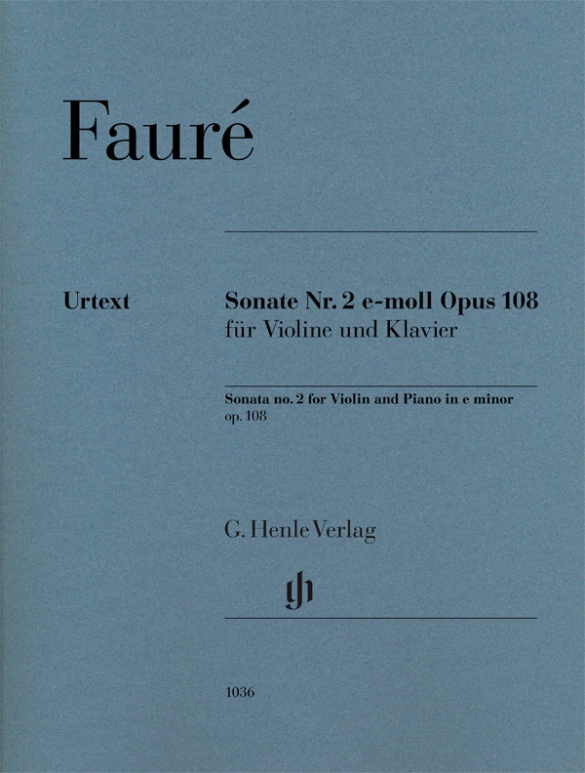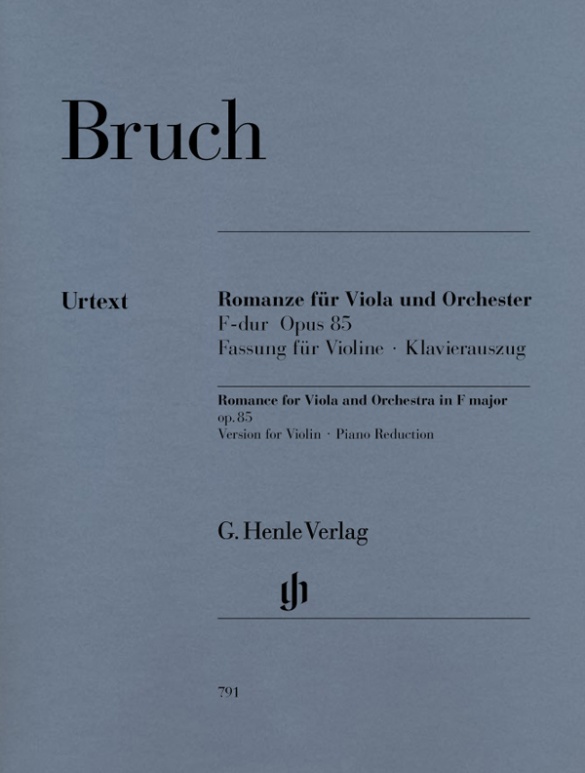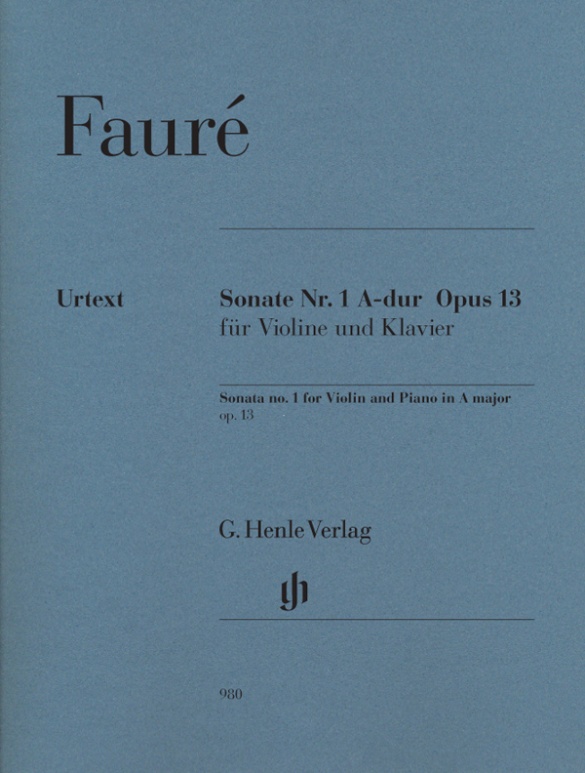

Gabriel Fauré
Violin Sonata no. 1 A major op. 13
Fauré composed his violin sonata in 1875/76 and in so doing opened up a new tradition for this genre in French music. In a review, Saint-Saëns expressed his enthusiasm for this work by his friend and pupil: "In this sonata you can find everything to tempt a gourmet: new forms, excellent modulations, unusual tone colours, and the use of unexpected rhythms.
And a magic floats above everything, encompassing the whole work, causing the crowd of usual listeners to accept the unimagined audacity as something quite normal. With this work Monsieur Fauré takes his place amongst the masters."
Read more about this edition in the Henle Blog.
Content/Details
About the Composer
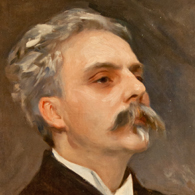
Gabriel Fauré
Representative exponent of French music around 1900. His creative work is centered around the art song, piano music (nocturnes, barcarolles, impromptus, valse-caprice), and chamber music – alongside other genres.
| 1845 | Born in Pamiers (Ariège) on May 12, the son of a primary school teacher. |
| 1854–65 | Attends the École de musique classique et religieuse (founded by L. Niedermeyer), where liturgical musicians were educated; lessons with Saint-Saëns (from 1861). |
| 1866–70 | Organist at the church of Saint-Sauveur in Rennes. |
| 1871 | After occupying various organist positions in Paris, he becomes assistant organist to Saint-Saëns at Saint-Sulpice. He numbers among the founding members of the Société nationale de musique. Performances of his works in their concerts. |
| 1874 | Premiere of his “Suite d’orchestre” in F major (“Symphony No. 1”), which is a compilation of existing pieces. |
| 1875/76 | Violin Sonata No. 1 in A major, Op. 13. |
| 1876–79 | Piano Quartet No. 1 in C minor, Op. 15 |
| 1877 | Maître de chapelle at Paris’s Église de la Madeleine. |
| 1876/78 | Premiere of his choral work “Les Djinns,” Op. 12. |
| from 1879 | Attends performances of Wagner’s music; in his own compositions he distances himself from Wagner. |
| 1885 | Premiere of his Symphony No. 2 in D minor, later destroyed. |
| 1887/88 | Requiem, Op. 48. |
| 1891 | “Cinq Mélodies ‘de Venise’,” Op. 58, on texts by Verlaine. |
| 1892–94 | “La bonne chanson,” Op. 61, on texts by Verlaine. |
| 1896 | Successor to Dubois at the Madeleine. He conducts a composition class at the Paris Conservatoire. |
| 1900 | Premiere of the tragédie lyrique “Prométhée,” Op. 82. |
| 1905–20 | Director of the Conservatoire. |
| 1909 | President of the Société musicale indépendante. |
| 1913 | Premiere in Monte Carlo of his opera “Pénélope.” |
| 1919 | Song cycle, “Mirages,” Op. 113, with clear features of his modernist late style. |
| 1924 | Death in Paris on November 4. |
About the Authors
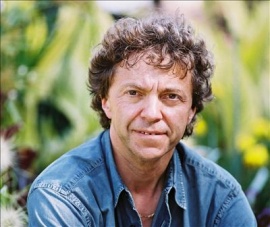
Pascal Rogé (Fingering)
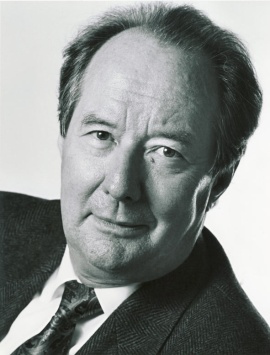
Igor Ozim (Fingering and bowing for Violin)
Prof. Igor Ozim was born in 1931 in Ljubljana, Slovenia. After completing his studies at the music conservatory there, he studied with Max Rostal in London, where he also won the Carl Flesch Competition in 1951. After winning the ARD Competition in 1953, he began a phase of intense concert activity in Europe and overseas.
His large repertoire encompasses over 60 violin concertos and numerous chamber music works. Many contemporary compositions, which he has premiered, are also dedicated to him. Ozim has performed with important international orchestras such as the Berlin Philharmonic, the London Philharmonic Orchestra, the London Symphony Orchestra, the Warsaw Philharmonic Orchestra, the BBC Orchestra as well as many radio orchestras. Igor Ozim has made many recordings of classical and contemporary works. As one of the most sought-after violin teachers in the world, he has taught at the music conservatories in Cologne and in Bern, as well as at the Mozarteum in Salzburg since 2002. Ozim has given master-classes around the world and is a jury member at many important competitions.
Product Safety Informations (GPSR)

G. Henle Verlag
Here you can find the information about the manufacturer of the product.G. Henle Verlag e.K.
Forstenrieder Allee 122
81476 München
Germany
info@henle.de
www.henle.com
Dieser Leipziger Erstdruck und ein autografes Arbeitsmanuskript des Komponisten sind die wesentlichen Quellen für die jetzt bei Henle erschienene Urtextausgabe, die nicht nur mit einem übersichtlichen und sauberen Druckbild aufwartet, sondern im Anhang auch zahlreiche Anmerkungen zu Bezeichnungen, Quellenabweichungen und Lesarten bereit hält.
Das Orchester, 2013推荐
autogenerated_cross_selling
本书目其他版本
本书目其他版本


